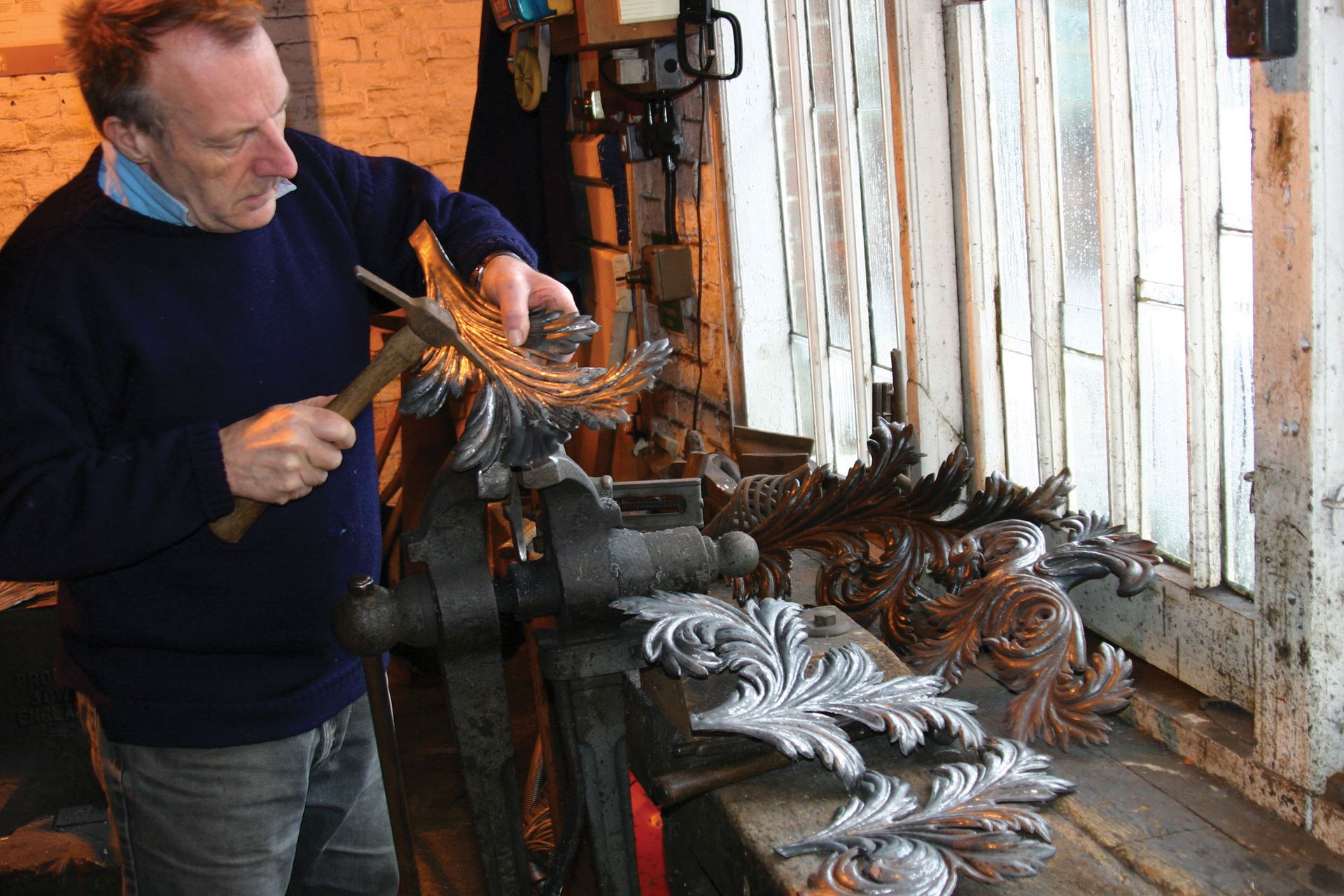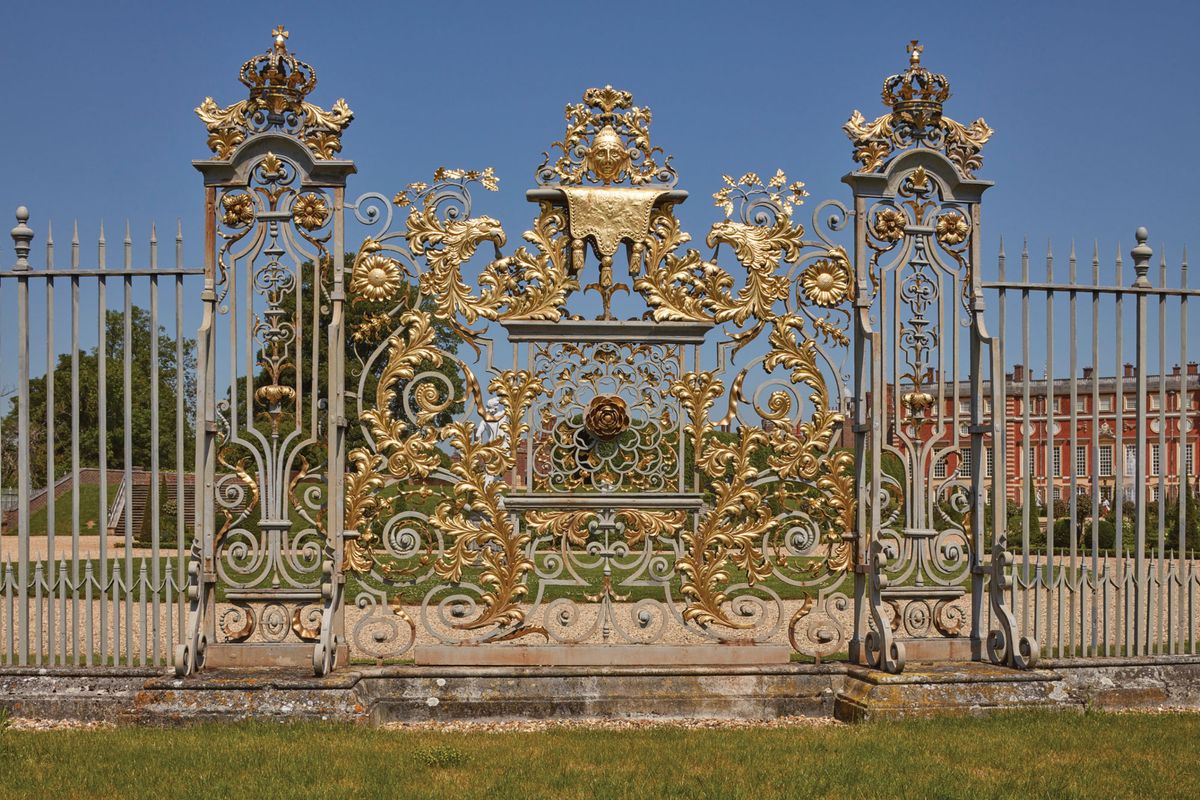The slot-head screws and overpainted dimples of old rivets are clues to the complex history of some of the most glorious examples of metalwork in England: the wrought iron Tijou screens, commissioned in 1689 from the French Huguenot craftsman Jean Tijou by the Protestant monarchs William and Mary, as the final flourish for their new fountain garden at Hampton Court Palace.
The screens were later moved—on one of their many journeys through the years—to their present location on the river bank of the palace’s Privy Garden, and a major restoration project has just seen the first of the dozen removed. It will be dismantled, stripped to the bare metal—a delicate operation since research has revealed that, in the 20th century, the screens went to an aircraft base for protective coatings of highly toxic paints—and studied. The aim is to correct centuries of erratic repairs: some replacement parts were reputedly rather touchingly made during the 1940s post-war shortages out of recycled filing cabinets, and many of the swirling acanthus leaves, swags of flowers, enigmatic masks and heraldic symbols are now dim copies of copies.
Tijou’s mysterious life
Devotees of the screens tend to become obsessed. The architect Andrew Harris—whose firm Martin Ashley Architects is working on the restoration with the charity Historic Royal Palaces, which manages Hampton Court—and the art historian Susanne Groom, have spent decades tracing their history. Groom has tracked down Tijou’s descendants, but still does not know exactly when he arrived in England to pick up prestigious ironwork commissions, including Chatsworth House in Derbyshire and St Paul’s Cathedral; nor is it known when he died or where he is buried. Groom does know that, with William and Mary both dead by the early 1700s, Tijou spent years chasing the final £1,000 payment for the screens.
By the 19th century Tijou’s authorship had been forgotten. A plaque in a local church attributes the screens to a Nottingham metalworker, Huntingdon Shaw, which earned him a statue among the great British architects, artists and craftsmen immortalised on the façade of the Victoria and Albert (V&A) Museum—much to Groom and Harris’s chagrin.
In the late 1800s the screens themselves were moved to the V&A, which never had space to display them all and sent them out on piecemeal loans, including one to Dublin ornamented with an Irish harp incorporating a busty lady. Another went to Nottingham, which struggled to keep it when the Prince of Wales launched a campaign to bring the set back to Hampton Court in 1902. Every time the screens were moved, delicate sections were damaged, stolen, or just fell off, as boxes of fragments in the stores of the V&A and Hampton Court prove. Ill-fitting or misplaced additions have also left their scars.

Metalworker Paul Allen at work on replacement leaves for the Tijou screens in his workshop at Motcombe, Dorset Photo: Courtesy of Paul Allen
After studying original drawings and fragments, new parts are now being made by the metalworker Paul Allen in Dorset, one of the few today who can execute the complex repoussé technique to Tijou’s standards, working the iron pieces from the back over a wooden block. It has taken him up to a day to draw out the pattern for a single leaf, leaving him in awe of the skill of his predecessors. Tijou “could not have done it all himself”, Allen thinks. “It was one heck of a job.”
This first screen will return to Hampton Court next spring, and its restoration—supported by the UK’s Heritage Stimulus Fund, part of the government’s £1.57bn Culture Recovery Fund—is expected to provide a wealth of information for work on the remaining 11.
Allen has now made enough leaves for two-and-a-half screens, but epic fundraising will be needed to continue the restoration: project manager Zoe Roberts estimates that this screen will cost up to £270,000, with work on all 12 amounting to perhaps £3m.
Many of the pieces being removed and replaced have accrued a century of history themselves, so the project raises interesting questions for the conservation team. “It is a philosophically tricky problem,” Harris admits, “but it is very clear that choices were made in the past to deviate [from Tijou’s original scheme] and we have the information to put most of that right.”


